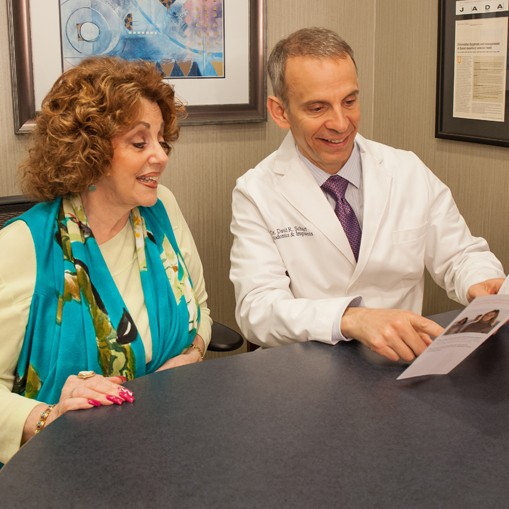Phases of Dental Implant
Treatment
Click above to see reviews.

Impressive Tooth Replacement Solution
Dental implants are in a league of their own as a tooth or teeth replacement solution. In addition to looking completely natural and being easy to take care of, dental implants have an impressive lifespan—capable of lasting twenty years or more or even a lifetime with proper care and maintenance.
Although the actual timeframe of your dental implant placement depends on your personal dental and bone health, regular dental implants can take anywhere from 4-12 months — unless you get the Teeth-In-a-Day procedure, which only takes a day. Here is an explanation of each phase of treatment so that you understand what to expect.
If you have any additional questions, please reach out to us. We want you to have all the information you need.
Initial Consultation
Before Dr. Scharf starts taking steps to install your dental implants, he will need to make sure that you are a good candidate for dental implant surgery. Although dental implant procedures have a very high success rate, hovering near 100%, implants can fail if the patient isn’t healthy enough for the procedure or isn’t dedicated to good oral hygiene practices.
As a board-certified periodontist, Dr. Scharf has received years of extra training regarding periodontal health and the placement of dental implants. Dr. Scharf will conduct a careful examination of your teeth, gums, bone tissue, and X-rays to see if you have jaw bone tissue that is healthy and strong enough to support implants. Dr. Scharf will also check to see if you have other issues that need to be addressed before implants, such as periodontal disease, gum recession, or underlying medical conditions that could affect your healing.
Find out if you are a candidate for dental implants by scheduling a consultation with Dr. Scharf.

Pre-Implant Surgery
Sometimes, patients are medically healthy enough for dental implant placement, but preparatory surgeries need to be completed in order to pave the way for a successful dental implant placement. For example, severely damaged teeth may need to be removed to make room for the implant, or bone grafts may be necessary to support the alveolar ridge. Both of these procedures require time to heal, but these steps can help to ensure that your implant will look great and feel comfortable.
Tooth Extractions
Teeth that are severely damaged cracked to the root, or infected may need extraction instead of repair. Dr. Scharf may recommend removing the tooth and installing a dental implant. Sometimes implants can be placed on the same day, but other times the area may need to heal before the implant placement.
Bone Grafting
After a few months of tooth loss or removal, the jaw bone starts to resorb in the area of the tooth loss. The resorption process is rapid, with bone tissue losing as much as 25% of its height within the first year, and then four additional millimeters the year afterward. Bone grafting can bolster the area and may be required to accommodate a dental implant. Bone grafting requires letting the area heal for at least four months.
Post Placement
As soon as the gum tissue and bone heal, implanting posts for your dental implants can begin. These dental implant “roots” are made of titanium and placed directly into the bone tissue. To do this, your jaw is numbed with a local anesthetic, then a small hole is pre-drilled to make it easier to place the post. Finally, the post is placed, and the gum tissue is closed around it.
After the post is in place, it needs time to integrate with the bone. This process can take as long as 4-6 months, depending on the original quality of the bone tissue. After the area has healed and the post is secure, the top of the post is uncovered and an abutment is attached to the post to hold the dental crown.
Final Crown Placement
Impressions of the exposed abutment and surrounding area are taken so that Dr. Scharf can order a dental crown that fits perfectly. The color of your existing teeth will be carefully matched, so your dental implant will blend right in. After the permanent crown comes in from the lab in a few weeks, you will be called back for a final appointment to have the crown placed. Because the underlying bone and gum tissue will be completely healed, your new dental implant will be ready to show off right after it is placed.
Do you have questions about the dental implant procedure? Call our office. We would love to hear from you.

Don’t Worry, We’re Here For You
Dr. Scharf and his entire team will be right by your side throughout the dental implant process. If you have any questions, complaints, or concerns during treatment, Dr. Scharf will do everything he can to make it right. We know that you will love your new dental implants in Long Island, and we can’t wait to get you started on your way to a new life.
Long Island Dental Implant Treatment
ADDRESS:
98 East Main Street
Babylon, NY 11702
Get Directions
PHONE: (631) 661-6633
OFFICE HOURS:
- Monday: 11:00 AM to 8:00 PM
- Tuesday: 9:00 AM to 8:00 PM
- Wednesday: 8:00 AM to 5:00 PM
- Thursday: 8:00 AM to 5:00 PM
- Friday: 8:00 AM to 5:00 PM
